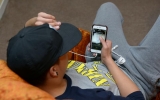A hotline offers support and resources for children and teenagers and all who care about them.

Child & Adolescent Hotline & Prevention Program
The Child & Adolescent Hotline and Prevention Program (CAHPP) is a hotline that is available 24/7 for parents of children of all ages, as well as educators, counselors, doctors, coaches, and members of the community.
The hotline number is 650-567-KIDS (5437).
“Can I talk to you if I’m being bullied?”
“I have had the worst day and just need to vent. Do you have a minute?”
“I’m having a bad day. Can I talk to you?”
These are calls, text and email messages that have come to a hotline for children and teenagers in San Mateo County and everyone who cares about them. The goal is to help students, parents, grandparents, teachers, coaches and others resolve or cope with stress and troubling issues before a crisis explodes.
Narges Dillon, program manager for StarVista, the local nonprofit that operates and staffs the hotline, said many teenagers need support due to pressures brought on by school, work, family strife or unhealthy relationships. Life can also be challenging for adults as well.
“It’s so hard to be a parent and it’s so hard to pick up the phone and ask for help,” she said. “The hotline is often the first time someone has reached out to talk to a therapist.”
Want to learn more about how Measure K funds are impacting Youth and Education?
Click here for updates and archived stories on our Measure K initiatives.
The hotline – 650-567-KIDS (5437) – is staffed 24 hours a day, seven days a week. From July 1, 2015, to June 30, 2016, the hotline received 655 initial inquiries with 2,365 follow-up contacts, a 10 percent increase in total inquiries and contacts from the prior year.
Fifty-six percent of people -- by telephone, text or email -- contacted the hotline with an inquiry about mental health. That was followed by requests for information (23 percent) and questions about parenting (9 percent).
The teenage years are often volatile. Suicide is the second leading cause of death for Americans between the ages of 15 and 24. (Suicide is the 10th leading cause of death for all Americans regardless of age.) Half of all lifetime cases of mental illness begin by age 14 and 75 percent by age 24.
Concerned about the health and mental health of youth and adolescents, the San Mateo County Board of Supervisors granted approximately $315,000 over two years to StarVista to launch and staff the hotline, which received its first call in November 2012. Funds are from a countywide half-cent sales tax approved by voters in 2012 and extended for 20 years by voters in 2016 (Measure K).
Now funded through mid-2017, StarVista has added full-time, master’s level staff fluent in Spanish and Mandarin Chinese. The hotline acts as a clearinghouse for a wide range of issues and can refer to, and access a broad spectrum of services and expertise within local governmental, non-profit and private-sector organizations.
“Creating a single point of contact allows us to expedite help to youth, as well as to track, and respond to, the changing needs of these youth over time,” said Iliana Rodriguez, Director of the County’s Human Services Agency.
Prevention and Early Intervention

Click on the graphic above to learn more about programs and services designed to help at-risk children, adolescents and teenagers as well as parents and other care-givers.
If a Mandarin speaker calls, texts or emails, they are referred to Dui (Dora) Chen, a StarVista mental health clinician fluent in Mandarin. This happened recently when an elderly woman called the hotline to say her teenage nephew had a mental health breakdown. Chen was able to contact Adult Protective Services and other agencies to defuse the situation and then follow up to ensure the nephew received mental health support.
“The stigma around mental health issues exists in the Chinese community, preventing people from asking for help,” Chen said.
Half of all cases of mental illness begin by the age of 14
A major challenge is simply spreading the word that the hotline exists. StarVista staff give presentations about the service, display information and answer questions at community events and hold workshops on youth mental health. The result?
“On days when a clinician provides a workshop or presentation to a group, especially youth, there is an increase in incoming inquiries,” said Stephanie Weisner, a StarVista director.

Because of the popularity of smart phones, a teenager can send a message to the hotline without drawing unwanted attention from anyone nearby.
The majority of contacts are by phone calls and emails (to 567kids@star-vista.org). But text messaging is growing in popularity as a way to reach out due to both the ubiquity of texting among teens and the anonymity; a teenager can text from anywhere without fear of being overheard or raising any suspicions.
Clinicians are trained to provide support to whoever is on the other end of the conversation and can provide referrals for additional services. Anyone who seems in a crisis or is thinking suicidal thoughts is seamlessly connected to a crisis hotline.
Parents and school personnel -- teachers, counselors and others -- account for more than half of the hotline's inquiries. Most common are questions about how to communicate tough news or discuss a troubling issue.
“Hi,” says one text. “Can you help me talk to my parents about not doing well in school?”
From a parent: “I want to introduce my children to my new significant other. Could you tell me the best way to tell them?”
Or this from a school principal: “I am calling with a student who wanted to talk to someone about some things going on for him at home.”
Dillon said the clinicians will keep an exchange going as long as it takes to find the root of the problem and a path forward.
“The art of therapy,” she said, “is engagement and support.”